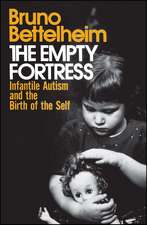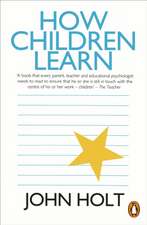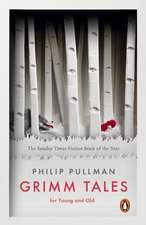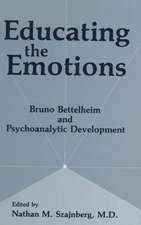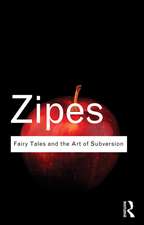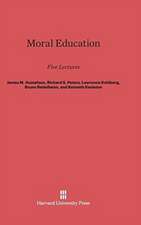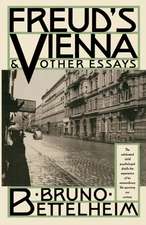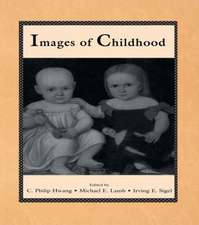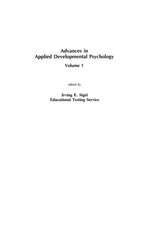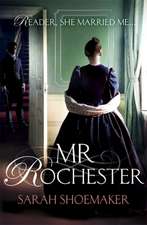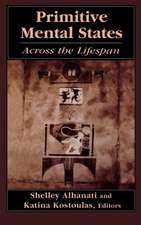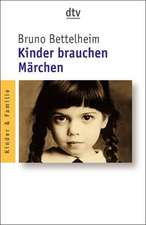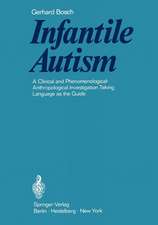The Uses of Enchantment: The Meaning and Importance of Fairy Tales
Autor Bruno Bettelheimen Limba Engleză Paperback – 30 apr 2010
Vezi toate premiile Carte premiată
Analyzing a wide range of traditional stories, from the tales of Sindbad to “The Three Little Pigs,” “Hansel and Gretel,” and “The Sleeping Beauty,” Bettelheim shows how the fantastical, sometimes cruel, but always deeply significant narrative strands of the classic fairy tales can aid in our greatest human task, that of finding meaning for one’s life.
| Toate formatele și edițiile | Preț | Express |
|---|---|---|
| Paperback (2) | 70.04 lei 3-5 săpt. | +10.62 lei 5-11 zile |
| Penguin Books – 24 apr 1991 | 70.04 lei 3-5 săpt. | +10.62 lei 5-11 zile |
| Vintage Books USA – 30 apr 2010 | 129.86 lei 17-23 zile | +11.26 lei 5-11 zile |
Preț: 129.86 lei
Nou
Puncte Express: 195
Preț estimativ în valută:
24.85€ • 25.80$ • 20.72£
24.85€ • 25.80$ • 20.72£
Carte disponibilă
Livrare economică 27 februarie-05 martie
Livrare express 15-21 februarie pentru 21.25 lei
Preluare comenzi: 021 569.72.76
Specificații
ISBN-13: 9780307739636
ISBN-10: 0307739635
Pagini: 328
Dimensiuni: 133 x 206 x 20 mm
Greutate: 0.26 kg
Editura: Vintage Books USA
ISBN-10: 0307739635
Pagini: 328
Dimensiuni: 133 x 206 x 20 mm
Greutate: 0.26 kg
Editura: Vintage Books USA
Recenzii
“Bettelheim argues convincingly that fairy tales provide a unique way for children to come to terms with the dilemmas of their inner lives.” —The Atlantic
“A charming book about enchantment, a profound book about fairy tales.” —John Updike, The New York Times Book Review
“A splendid achievement, brimming with useful ideas, with insights into how young children read and understand, and most of all overflowing with a realistic optimism and with an experienced and therapeutic good will.” —Harold Bloom, The New York Review of Books
“Provocative and persuasive.” —Boston Globe
“A charming book about enchantment, a profound book about fairy tales.” —John Updike, The New York Times Book Review
“A splendid achievement, brimming with useful ideas, with insights into how young children read and understand, and most of all overflowing with a realistic optimism and with an experienced and therapeutic good will.” —Harold Bloom, The New York Review of Books
“Provocative and persuasive.” —Boston Globe
Notă biografică
Bruno Bettelheim was born in Vienna in 1903. He received his doctorate at the University of Vienna and came to America in 1939, after a year in the concentration camps of Dachau and Buchenwald. He was a Distinguished Professor of Education and Professor of both psychology and psychiatry at the University of Chicago. He died in 1990.
Extras
LIFE DIVINED FROM THE INSIDE
“Little Red Riding Hood was my first love. I felt that if I could have married Little Red Riding Hood, I should have known perfect bliss.” This statement by Charles Dickens indicates that he, like untold millions of children all over the world throughout the ages, was enchanted by fairy tales. Even when world-famous, Dickens acknowledged the deep formative impact that the wondrous figures and events of fairy tales had had on him and his creative genius. He repeatedly expressed scorn for those who, motivated by an uninformed and petty rationality, insisted on rationalizing, bowdlerizing, or outlawing these stories, and thus robbed children of the important contributions fairy tales could make to their lives. Dickens understood that the imagery of fairy tales helps children better than anything else in their most difficult and yet most important and satisfying task: achieving a more mature consciousness to civilize the chaotic pressures of their unconscious.
Today, as in the past, the minds of both creative and average children can be opened to an appreciation of all the higher things in life by fairy tales, from which they can move easily to enjoying the greatest works of literature and art. The poet Louis MacNeice, for example, tells that “Real fairy stories always meant much to me as a person, even when I was at a public school where to admit this meant losing face. Contrary to what many people say even now, a fairy story, at least of the classical folk variety, is a much more solid affair than the average naturalistic novel, whose hooks go little deeper than a gossip column. From folk tales and sophisticated fairy tales such as Hans Andersen's or Norse mythology and stories like the Alice books and Water Babies I graduated, at about the age of twelve, to the Faerie Queene.” Literary critics such as G. K. Chesterton and C. S. Lewis felt that fairy stories are “spiritual explorations” and hence “the most life-like” since they reveal “human life as seen, or felt, or divined from the inside.”
Fairy tales, unlike any other form of literature, direct the child to discover his identity and calling, and they also suggest what experiences are needed to develop his character further. Fairy tales intimate that a rewarding, good life is within one's reach despite adversity ߝ but only if one does not shy away from the hazardous struggles without which one can never achieve true identity. These stories promise that if a child dares to engage in this fearsome and taxing search, benevolent powers will come to his aid, and he will succeed. The stories also warn that those who are too timorous and narrow minded to risk themselves in finding themselves must settle down to a humdrum existence-if an even worse fate does not befall them.
Past generations of children who loved and felt the importance of fairy tales were subjected to the scorn only of pedants, as happened to MacNeice. Today many of our children are far more grievously bereaved-because they are deprived of the chance to know fairy stories at all. Most children now meet fairy tales only in prettified and simplified versions which subdue their meaning and rob them of all deeper significance-versions such as those on films and TV shows, where fairy tales are turned into empty-minded entertainment.
Through most of man's history, a child's intellectual life, apart from immediate experiences within the family, depended on mythical and religious stories and on fairy tales. This traditional literature fed the child's imagination and stimulated his fantasizing. Simultaneously, since these stories answered the child's most important questions, they were a major agent of his socialization. Myths and closely related religious legends offered material from which children formed their concepts of the world's origin and purpose, and of the social ideals a child could pattern himself after. These were the images of the unconquered hero Achilles and wily Odysseus; of Hercules, whose life history showed that it is not beneath the dignity of the strongest man to clean the filthiest stable; of St. Martin, who cut his coat in half to clothe a poor beggar. It is not just since Freud that the myth of Oedipus has become the image by which we understand the ever new but age-old problems posed to us by our complex and ambivalent feelings about our parents. Freud referred to this ancient story to make us aware of the inescapable cauldron of emotions which every child, in his own way, has to manage at a certain age.
In the Hindu civilization, the story of Rama and Sita (part of the Ramayana), which tells of their peaceable courage and their passionate devotion to each other, is the prototype of love and marriage relationships. The culture, moreover, enjoins everyone to try to relive this myth in his or her own life; every Hindu bride is called Sita, and as part of her wedding ceremony she acts out certain episodes of the myth.
In a fairy internal processes are externalized and become comprehensible as represented by the figures of the story and its events. This is the reason why in traditional Hindu medicine a fairy tale giving form to his particular problem was offered to a psychically disoriented person, for his meditation. It was expected that through contemplating the story the disturbed person would be led to visualize both the nature of the impasse in living from which he suffered, and the possibility of its resolution. From what a particular tale implied about man's despair, hopes, and methods of overcoming tribulations, the patient could discover not only a way out of his distress but also a way to find himself, as the hero of the story did.
But the paramount importance of fairy tales for the growing individual resides in something other than teachings about correct ways of behaving in this world-such wisdom is plentifully supplied in religion, myths, and fables. Fairy stories do not pretend to describe the world as it is, nor do they advise what one ought to do. If they did, the Hindu patient would be induced to follow an imposed pattern of behavior-which is not just bad therapy, but the opposite of therapy. The fairy tale is therapeutic because the patient finds his own solutions, through contemplating what the story seems to imply about him and his inner conflicts at this moment in his life. The content of the chosen tale usually has nothing to do with the patient's external life, but much to do with his inner problems, which seem incomprehensible and hence unsolvable. The fairy tale clearly does not refer to the outer world, although it may begin realistically enough and have everyday features woven into it. The unrealistic nature of these tales (which narrow-minded rationalists object to) is an important device, because it makes obvious that the fairy tales' concern is not useful information about the external world, but the inner processes taking place in an individual.
In most cultures, there is no clear line separating myth from folk or fairy tale; all these together form the literature of preliterate societies. The Nordic languages have only one word for both: saga. German has retained the word Sage for myths, while fairy stories are called Märchen. It is unfortunate that both the English and French names for these stories emphasize the role of fairies in them-because in most, no fairies appear. Myths and fairy tales alike attain a definite form only when they are committed to writing and are no longer subject to continuous change. Before being written down, these stories were either condensed or vastly elaborated in the retelling over the centuries; some stories merged with others. All became modified by what the teller thought was of greatest interest to his listeners, by what his concerns of the moment or the special problems of his era were.
Some fairy and folk stories evolved out of myths; others were incorporated into them. Both forms embodied the cumulative experience of a society as men wished to recall past wisdom for themselves and transmit it to future generations. These tales are the purveyors of deep insights that have sustained mankind through the long vicissitudes of its existence, a heritage that is not revealed in any other form as simply and directly, or as accessibly, to children.
Myths and fairy tales have much in common. But in myths, much more than in fairy stories, the culture hero is presented to the listener as a figure he ought to emulate in his own life, as far as possible.
A myth, like a fairy tale, may express an inner conflict in symbolic form and suggest how it may be solved-but this is not necessarily the myth's central concern. The myth presents its theme in a majestic way; it carries spiritual force; and the divine is present and is experienced in the form of superhuman heroes who make constant demands on mere mortals. Much as we, the mortals, may strive to be like these heroes, we will remain always and obviously inferior to them.
The figures and events of fairy tales also personify and illustrate inner conflicts, but they suggest ever so subtly how these conflicts may be solved, and what the next steps in the development toward a higher humanity might be. The fairy tale is presented in a simple, homely way; no demands are made on the listener. This prevents even the smallest child from feeling compelled to act in specific ways, and he is never made to feel inferior. Far from making demands, the fairy tale reassures, gives hope for the future, and holds out the promise of a happy ending. That is why Lewis Carroll called it a "love-gift" -a term hardly applicable to a myth.*
Obviously, not every story contained in a collection called "Fairy Tales" meets these criteria. Many of these stories are simply diversions, cautionary tales, or fables. If they are fables, they tell by means of words, actions, or events-fabulous though these may be-what one ought to do. Fables demand and threaten-they are moralistic-or they just entertain. To decide whether a story is a fairy tale or something entirely different, one might ask whether it could rightly be called a love-gift to a child. That is not a bad way to arrive at a classification.
To understand how a child views fairy tales, let us consider as examples the many fairy stories in which a child outwits a giant who scares him or even threatens his life. That children intuitively understand what these “giants” stand for is illustrated by the spontaneous reaction of a five-year-old.
Encouraged by discussion about the importance fairy tales have for children, a mother overcame her hesitation about telling such “gory and threatening” stories to her son. From her conversations with him, she knew that her son already had fantasies about eating people, or people getting eaten. So she told him the tale of “Jack the Giant Killer.” His response at the end of the story was: “There aren't any such things as giants, are there?” Before the mother could give her son the reassuring reply which was on her tongue-and which would have destroyed the value of the story for him-he continued, “But there are such things as grownups, and they're like giants.” At the ripe old age of five, he understood the encouraging message of the story: although adults can be experienced as frightening giants, a little boy with cunning can get the better of them.
This remark reveals one source of adult reluctance to tell fairy stories: we are not comfortable with the thought that occasionally we look like threatening giants to our children, although we do. Nor do we want to accept how easy they think it is to fool us, or to make fools of us, and how delighted they are by this idea. But whether or not we tell fairy tales to them, we do-as the example of this little boy proves -appear to them as selfish giants who wish to keep to ourselves all the wonderful things which give us power. Fairy stories provide reassurance to children that they can eventually the better of the giant ߝ i.e., they can grow up to be like the giant and acquire the same powers. These are “the mighty hopes that make us men.”
Most significantly, if we parents tell such fairy stories to our children, we can give them the most important reassurance of all: that we approve of their playing with the idea of getting the better of these giants. Here reading is not the same as being told the story, because while reading alone the child may think that only some stranger-the person who wrote the story or arranged the book-approves of outwitting and cutting down the giant. But when his parents tell him the story, a child can be sure that they approve of his retaliating in fantasy for the threat which adult dominance entails.
*Child of the pure unclouded brow
And dreaming eyes of wonder!
Though time be fleet, and I and thou
“Little Red Riding Hood was my first love. I felt that if I could have married Little Red Riding Hood, I should have known perfect bliss.” This statement by Charles Dickens indicates that he, like untold millions of children all over the world throughout the ages, was enchanted by fairy tales. Even when world-famous, Dickens acknowledged the deep formative impact that the wondrous figures and events of fairy tales had had on him and his creative genius. He repeatedly expressed scorn for those who, motivated by an uninformed and petty rationality, insisted on rationalizing, bowdlerizing, or outlawing these stories, and thus robbed children of the important contributions fairy tales could make to their lives. Dickens understood that the imagery of fairy tales helps children better than anything else in their most difficult and yet most important and satisfying task: achieving a more mature consciousness to civilize the chaotic pressures of their unconscious.
Today, as in the past, the minds of both creative and average children can be opened to an appreciation of all the higher things in life by fairy tales, from which they can move easily to enjoying the greatest works of literature and art. The poet Louis MacNeice, for example, tells that “Real fairy stories always meant much to me as a person, even when I was at a public school where to admit this meant losing face. Contrary to what many people say even now, a fairy story, at least of the classical folk variety, is a much more solid affair than the average naturalistic novel, whose hooks go little deeper than a gossip column. From folk tales and sophisticated fairy tales such as Hans Andersen's or Norse mythology and stories like the Alice books and Water Babies I graduated, at about the age of twelve, to the Faerie Queene.” Literary critics such as G. K. Chesterton and C. S. Lewis felt that fairy stories are “spiritual explorations” and hence “the most life-like” since they reveal “human life as seen, or felt, or divined from the inside.”
Fairy tales, unlike any other form of literature, direct the child to discover his identity and calling, and they also suggest what experiences are needed to develop his character further. Fairy tales intimate that a rewarding, good life is within one's reach despite adversity ߝ but only if one does not shy away from the hazardous struggles without which one can never achieve true identity. These stories promise that if a child dares to engage in this fearsome and taxing search, benevolent powers will come to his aid, and he will succeed. The stories also warn that those who are too timorous and narrow minded to risk themselves in finding themselves must settle down to a humdrum existence-if an even worse fate does not befall them.
Past generations of children who loved and felt the importance of fairy tales were subjected to the scorn only of pedants, as happened to MacNeice. Today many of our children are far more grievously bereaved-because they are deprived of the chance to know fairy stories at all. Most children now meet fairy tales only in prettified and simplified versions which subdue their meaning and rob them of all deeper significance-versions such as those on films and TV shows, where fairy tales are turned into empty-minded entertainment.
Through most of man's history, a child's intellectual life, apart from immediate experiences within the family, depended on mythical and religious stories and on fairy tales. This traditional literature fed the child's imagination and stimulated his fantasizing. Simultaneously, since these stories answered the child's most important questions, they were a major agent of his socialization. Myths and closely related religious legends offered material from which children formed their concepts of the world's origin and purpose, and of the social ideals a child could pattern himself after. These were the images of the unconquered hero Achilles and wily Odysseus; of Hercules, whose life history showed that it is not beneath the dignity of the strongest man to clean the filthiest stable; of St. Martin, who cut his coat in half to clothe a poor beggar. It is not just since Freud that the myth of Oedipus has become the image by which we understand the ever new but age-old problems posed to us by our complex and ambivalent feelings about our parents. Freud referred to this ancient story to make us aware of the inescapable cauldron of emotions which every child, in his own way, has to manage at a certain age.
In the Hindu civilization, the story of Rama and Sita (part of the Ramayana), which tells of their peaceable courage and their passionate devotion to each other, is the prototype of love and marriage relationships. The culture, moreover, enjoins everyone to try to relive this myth in his or her own life; every Hindu bride is called Sita, and as part of her wedding ceremony she acts out certain episodes of the myth.
In a fairy internal processes are externalized and become comprehensible as represented by the figures of the story and its events. This is the reason why in traditional Hindu medicine a fairy tale giving form to his particular problem was offered to a psychically disoriented person, for his meditation. It was expected that through contemplating the story the disturbed person would be led to visualize both the nature of the impasse in living from which he suffered, and the possibility of its resolution. From what a particular tale implied about man's despair, hopes, and methods of overcoming tribulations, the patient could discover not only a way out of his distress but also a way to find himself, as the hero of the story did.
But the paramount importance of fairy tales for the growing individual resides in something other than teachings about correct ways of behaving in this world-such wisdom is plentifully supplied in religion, myths, and fables. Fairy stories do not pretend to describe the world as it is, nor do they advise what one ought to do. If they did, the Hindu patient would be induced to follow an imposed pattern of behavior-which is not just bad therapy, but the opposite of therapy. The fairy tale is therapeutic because the patient finds his own solutions, through contemplating what the story seems to imply about him and his inner conflicts at this moment in his life. The content of the chosen tale usually has nothing to do with the patient's external life, but much to do with his inner problems, which seem incomprehensible and hence unsolvable. The fairy tale clearly does not refer to the outer world, although it may begin realistically enough and have everyday features woven into it. The unrealistic nature of these tales (which narrow-minded rationalists object to) is an important device, because it makes obvious that the fairy tales' concern is not useful information about the external world, but the inner processes taking place in an individual.
In most cultures, there is no clear line separating myth from folk or fairy tale; all these together form the literature of preliterate societies. The Nordic languages have only one word for both: saga. German has retained the word Sage for myths, while fairy stories are called Märchen. It is unfortunate that both the English and French names for these stories emphasize the role of fairies in them-because in most, no fairies appear. Myths and fairy tales alike attain a definite form only when they are committed to writing and are no longer subject to continuous change. Before being written down, these stories were either condensed or vastly elaborated in the retelling over the centuries; some stories merged with others. All became modified by what the teller thought was of greatest interest to his listeners, by what his concerns of the moment or the special problems of his era were.
Some fairy and folk stories evolved out of myths; others were incorporated into them. Both forms embodied the cumulative experience of a society as men wished to recall past wisdom for themselves and transmit it to future generations. These tales are the purveyors of deep insights that have sustained mankind through the long vicissitudes of its existence, a heritage that is not revealed in any other form as simply and directly, or as accessibly, to children.
Myths and fairy tales have much in common. But in myths, much more than in fairy stories, the culture hero is presented to the listener as a figure he ought to emulate in his own life, as far as possible.
A myth, like a fairy tale, may express an inner conflict in symbolic form and suggest how it may be solved-but this is not necessarily the myth's central concern. The myth presents its theme in a majestic way; it carries spiritual force; and the divine is present and is experienced in the form of superhuman heroes who make constant demands on mere mortals. Much as we, the mortals, may strive to be like these heroes, we will remain always and obviously inferior to them.
The figures and events of fairy tales also personify and illustrate inner conflicts, but they suggest ever so subtly how these conflicts may be solved, and what the next steps in the development toward a higher humanity might be. The fairy tale is presented in a simple, homely way; no demands are made on the listener. This prevents even the smallest child from feeling compelled to act in specific ways, and he is never made to feel inferior. Far from making demands, the fairy tale reassures, gives hope for the future, and holds out the promise of a happy ending. That is why Lewis Carroll called it a "love-gift" -a term hardly applicable to a myth.*
Obviously, not every story contained in a collection called "Fairy Tales" meets these criteria. Many of these stories are simply diversions, cautionary tales, or fables. If they are fables, they tell by means of words, actions, or events-fabulous though these may be-what one ought to do. Fables demand and threaten-they are moralistic-or they just entertain. To decide whether a story is a fairy tale or something entirely different, one might ask whether it could rightly be called a love-gift to a child. That is not a bad way to arrive at a classification.
To understand how a child views fairy tales, let us consider as examples the many fairy stories in which a child outwits a giant who scares him or even threatens his life. That children intuitively understand what these “giants” stand for is illustrated by the spontaneous reaction of a five-year-old.
Encouraged by discussion about the importance fairy tales have for children, a mother overcame her hesitation about telling such “gory and threatening” stories to her son. From her conversations with him, she knew that her son already had fantasies about eating people, or people getting eaten. So she told him the tale of “Jack the Giant Killer.” His response at the end of the story was: “There aren't any such things as giants, are there?” Before the mother could give her son the reassuring reply which was on her tongue-and which would have destroyed the value of the story for him-he continued, “But there are such things as grownups, and they're like giants.” At the ripe old age of five, he understood the encouraging message of the story: although adults can be experienced as frightening giants, a little boy with cunning can get the better of them.
This remark reveals one source of adult reluctance to tell fairy stories: we are not comfortable with the thought that occasionally we look like threatening giants to our children, although we do. Nor do we want to accept how easy they think it is to fool us, or to make fools of us, and how delighted they are by this idea. But whether or not we tell fairy tales to them, we do-as the example of this little boy proves -appear to them as selfish giants who wish to keep to ourselves all the wonderful things which give us power. Fairy stories provide reassurance to children that they can eventually the better of the giant ߝ i.e., they can grow up to be like the giant and acquire the same powers. These are “the mighty hopes that make us men.”
Most significantly, if we parents tell such fairy stories to our children, we can give them the most important reassurance of all: that we approve of their playing with the idea of getting the better of these giants. Here reading is not the same as being told the story, because while reading alone the child may think that only some stranger-the person who wrote the story or arranged the book-approves of outwitting and cutting down the giant. But when his parents tell him the story, a child can be sure that they approve of his retaliating in fantasy for the threat which adult dominance entails.
*Child of the pure unclouded brow
And dreaming eyes of wonder!
Though time be fleet, and I and thou
Descriere
A famous child psychologist explains how fairy tales educate, support, and liberate the emotions of children.
Premii
- National Book Critics Circle Award Winner, 1976

